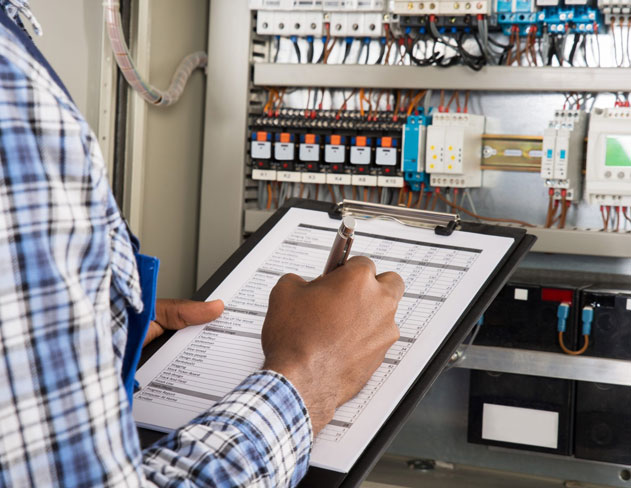A guide to electrical testing
Staying on top of electrical safety checks is non-negotiable for any public property or workplace. Licensed electricians have meticulous inspection processes to catch issues before disaster strikes. They thoroughly probe the inner workings of electrical systems – testing wiring integrity so aging components don’t unexpectedly fail, examining insulation resistance to ensure dangerous current leakage doesn’t develop, and verifying protective switches still trip effectively when abnormalities occur. It’s intricate work validating all these safeguards still operate as intended over years of wear.
In the UK, these comprehensive assessments also form the basis of legally required certification that business premises and rental properties must periodically obtain and have available for review. Lapses in inspection schedules undermine compliance. When electricians dive deep into checking continuity, insulation, automatic trip responses and more though, they can confirm that safety fundamentals remain intact, keeping occupants secure. It’s precise, preventative maintenance work that avoids catastrophic chain reactions down the line. Staying current with certified testing keeps infrastructure robust and resilient for the long haul.
Importance of electrical testing for safety and compliance
Property managers and business owners have an ethical and legal responsibility to protect their patrons, residents and assets from electrical safety hazards. Within complexes wired over time, risks can secretly emerge – from damaged cabling to faulty protective relays. That’s where electrical testing comes in as a routine safeguard.
Licensed electricians methodically examine underlying electrical infrastructure, leveraging specialised equipment to benchmark key integrity metrics before issues arise. They verify cabling continuity hasn’t degraded over decades to the point conductors might abruptly fail. They confirm insulation material is still resistant to dangerous current leakage even after microscopic fissures accumulate. They ensure emergency relays remain calibrated to instantly trip systems when abnormalities occur. It’s scientific assurance that electrical foundations won’t falter.
UK legislation demands landlords and employers uphold these safety infrastructure certifications as part of compulsory due diligence. Lapses can yield major penalties if preventable accidents strike. Passing comprehensive electrical checks also keeps insurance carriers content in many cases. Staying current on critical safety validations – from cabling and insulation to automated trip settings – is about staying legally compliant and morally accountable in managing real estate or business premises where lives are on the line. It’s a fundamental piece of operating safely.
Different types of electrical testing procedures
Electricians come armed with an array of equipment for methodically inspecting electrical systems. Before touching any components, they use non-contact voltage testers to pinpoint exactly where electricity is flowing to avoid surprises. Once the circuits are confirmed dead, they grab continuity testers to send current through wires while measuring resistance to uncover any hidden frays or breaks before failure. Multimeters then diagnose specifics like voltage and amperage at different points to catch improper connections or overload risks. Clamp metres take it a step further, encircling bundles of cabling to map out actual load levels in real-time across circuits.
Each diagnostic tool provides unique objective data, building blocks for a comprehensive electrical health profile. Non-contact mapping prevents mishaps, continuity findings catch simmering wiring defects, multimeter readings identify connection issues, and clamp verifications reveal overload threats before they spiral. It’s a meticulous sequence electricians have honed over years in the field. By methodically combining specialised equipment, they can thoroughly validate that electricity is flowing properly across infrastructure to prevent hazards. It’s a behind-the-scenes process that keeps the lights on safely.
Key qualifications to look for in an electrician
Assessing Experience and Expertise
When searching for an electrician, it’s essential to vet both competency and relevant expertise. Look at qualifications beyond just general training. Delving into specialised knowledge is key. Have they mastered nuanced skills like accurately determining electrical loads for equipment specifications? That prevents overtaxing infrastructure. Can they comprehensively identify risks and shape solutions? That’s crucial for hazard prevention. Do they have documented experience testing backup lighting systems to official British Standards? Those are complex, hyper-specific assessments.
Ideally, they should also have an established track record dealing with your particular business sector and configurations too. Hospitality electrical work calls for grasping entertainment venue idiosyncrasies, like safely interweaving sound, lighting, food equipment. Manufacturing sector knowledge requires navigating high-power machinery testing. Seek industry-tailored experience.
Look beyond named credentials too for clues of competency. Positive client references demonstrate successful electrical work out in the real world. Prestigious certifications signal deep understanding and up-to-date best practice knowledge right at the cutting edge of advances. It takes deliberate effort for electricians to pursue continuing high-level education.

